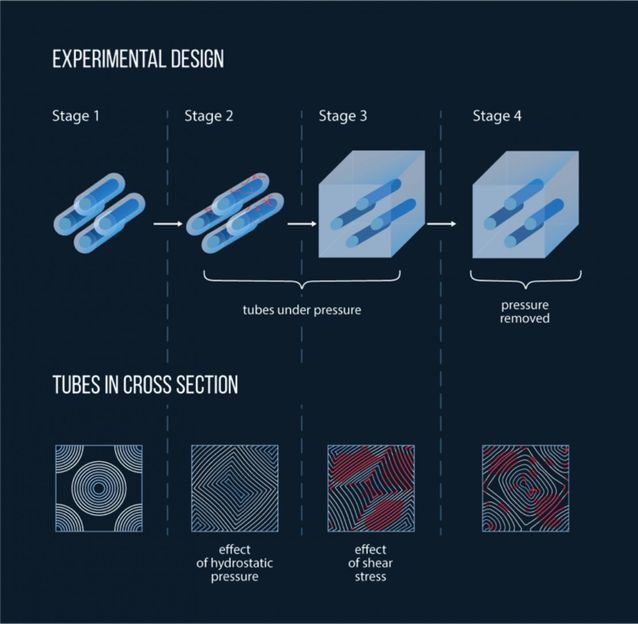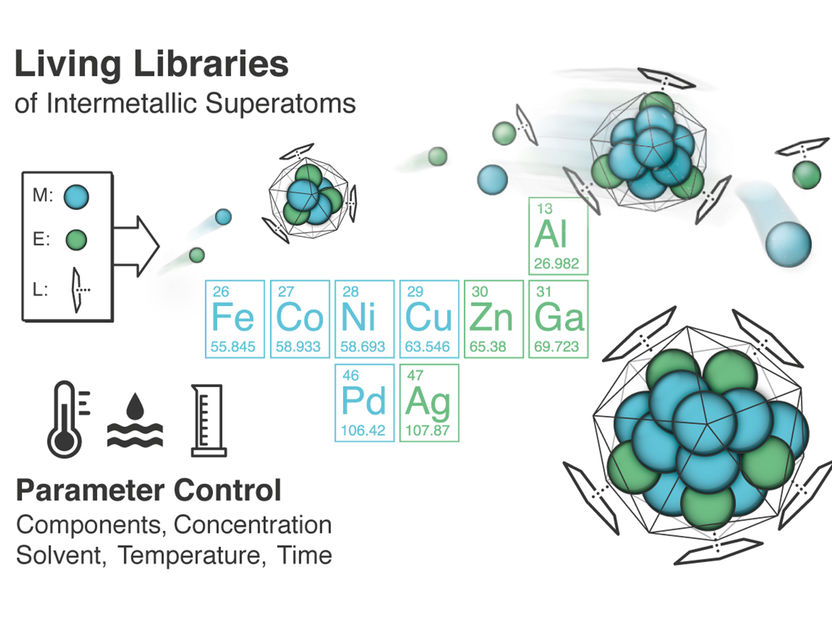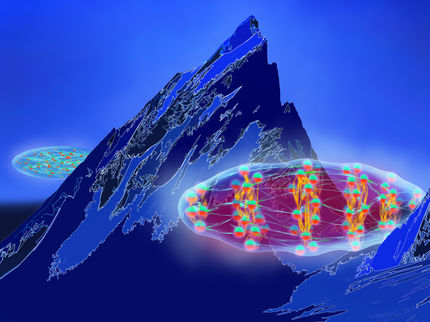Scrambled supersolids
Surprisingly reversible
supersolids are fluid and solid at the same time. Physicists from Innsbruck and Geneva have for the first time investigated what happens when such a state is brought out of balance. They discovered a soft form of a solid of high interest for science. As the researchers led by Francesca Ferlaino and Thierry Giamarchi report in Nature Physics, they were also able to reverse the process and restore supersolidity.

Without the superfluid background bath the quantum droplets quickly lose knowledge about each other and start to dephase.
IQOQI Innsbruck/Harald Ritsch
Last year, more than fifty years after initial theoretical proposals, researchers in Pisa, Stuttgart and Innsbruck independently succeeded for the first time in creating so-called supersolids using ultracold quantum gases of highly magnetic lanthanide atoms. This state of matter is, in a sense, solid and liquid at the same time. "Due to quantum effects, a very cold gas of atoms can spontaneously develop both a crystalline order of a solid crystal and particle flow like a superfluid quantum liquid, i.e. a fluid able to flow without any friction" explains Francesca Ferlaino from the Institute for Quantum Optics and Quantum Information of the Austrian Academy of Sciences and the Department of Experimental Physics at the University of Innsbruck. “Much simplified, a dipolar supersolid can be imagined as a chain of quantum droplets which communicate with each other via a superfluid background bath,” says Thierry Giamarchi, theoretical physicist from the University of Geneva.
Surprisingly reversible
In Nature Physics, the researchers now report how such a supersolid state reacts if the superfluid bath between the droplets is drained by control of the external magnetic field. “We were able to show that without the bath the droplets quickly lose knowledge about each other and start to behave like small independent quantum systems – they dephase. The supersolid turns into a normal solid,” says Maximilian Sohmen from Francecsa Ferlaino's team. “This 'solid', however, is still soft, it can wobble and support many collective excitations, called phonons”, adds Philipp Ilzhöfer from the Innsbruck team. “This makes this state a very interesting but complex subject of study with strong connections to solid-state physics and other fields.”
Maybe surprisingly, the Innsbruck physicists were also able to reverse this dephasing process: When they replenished the background bath, the droplets renewed their communication by particle tunneling and re-established supersolidity.
Original publication
Original publication
"Phase coherence in out-of-equilibrium supersolid states of ultracold dipolar atoms"; P. Ilzhöfer, M. Sohmen, G. Durastante, C. Politi , A. Trautmann, G. Natale, G. Morpurgo, T. Giamarchi, L. Chomaz, M. J. Mark, and F. Ferlaino; Nature Physics; 2020
Organizations
Other news from the department science

Get the chemical industry in your inbox
By submitting this form you agree that LUMITOS AG will send you the newsletter(s) selected above by email. Your data will not be passed on to third parties. Your data will be stored and processed in accordance with our data protection regulations. LUMITOS may contact you by email for the purpose of advertising or market and opinion surveys. You can revoke your consent at any time without giving reasons to LUMITOS AG, Ernst-Augustin-Str. 2, 12489 Berlin, Germany or by e-mail at revoke@lumitos.com with effect for the future. In addition, each email contains a link to unsubscribe from the corresponding newsletter.
Most read news
More news from our other portals
Last viewed contents
New start for the Methacrylate Verbund of Evonik Industries - Röhm excited to continue as an independent company

'Pressure-welding' nanotubes creates ultrastrong material
Heraeus Group Announces Growth in Revenues and Earnings Despite Softening of Key Markets
Energy_policy_of_the_United_Kingdom
LANXESS: New rubber production line opens in Dormagen

Superatoms as catalysts - Prof. Roland Fischer awarded Reinhard Koselleck Project funding from the DFG
LGC and CIA take major step to establish REACH Centre - LGC and CIA announce joint initiative to help chemical companies implement REACH regulations
Merquinsa appoints Zylog Plastalloys to distribute in India its TPU specialty elastomers product ranges
NOVA Chemicals and GRUPO IDESA to Form Styrenic Polymers Joint Venture in Mexico
Dr. Stefan Beckmann is the new head of Care Chemicals and Formulators Europe at BASF




























































